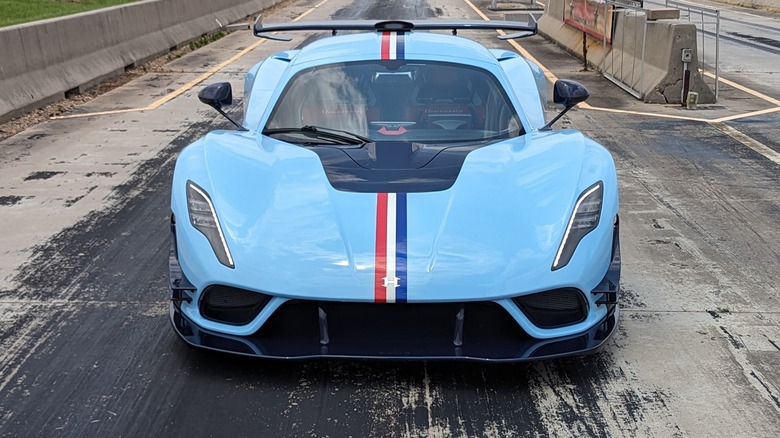
Dave McQuilling/SlashGear
By the end of 2024, the Hennessey Venom F5 may officially be the fastest car in the world. If it achieves that goal, it will have done so with a 6.6 liter twin-turbo V8 providing all of the power. Somehow, that V8 is producing 1,817 horsepower at its peak and–aside from a starter–no electric motors are giving it an extra kick. It’s pure combustion all the way.
What may be even more impressive is the power-to-weight ratio, which at 1,298 horsepower per ton is pretty remarkable. To achieve that level of lightness, most of the vehicle has been built from carbon fiber — and that also adds to the styling on many models. In terms of appearance, the Venom F5 arguably has more of a classic European look than anything American, a bit like the Shelby Cobra did back in the day. In terms of performance, there’s a suggestion that the Venom F5 could go all the way to 330 mph, John Hennessey himself believes it’s at least capable of 315 mph, and the test driver will be aiming for 311 on the speedo at the very least.
I recently got an invite to Sealy, Texas, where Hennessey Performance is based and that came with an opportunity to spend a short amount of time in and around the Venom F5. While I didn’t get the chance to push it to its limits (for obvious reasons), it was more than enough to understand what the F5 has to offer.
It’s pretty fast, believe it or not
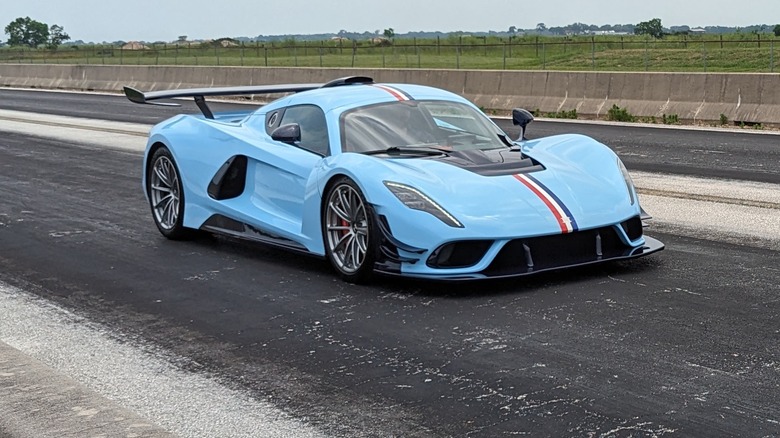
Dave McQuilling/SlashGear
The Venom F5 was built with a clear purpose in mind: John Hennessy wants his name attached to another production car speed record. The only thing seemingly standing in its way is the lack of a venue. A six-mile straight is required to get it up to speed and back down to zero safely.
In non-record setting settings, the Venom F5 will blast up towards 200 mph before you know it. Just briefly and gently getting my foot down on the dragstrip at Hennessy’s headquarters saw the needle nudge into the high 160s, and that was in Sport mode.
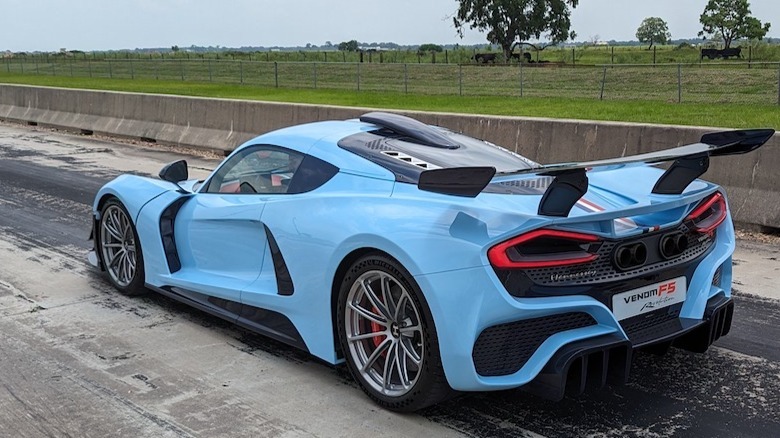
Sport is one of five drive modes available, with the others being Wet, Drag, Track, and «F5.» «F5» unlocks the vehicle’s full potential, making the throttle response and gear changes far more aggressive. With F5 mode and a rolling start, you can hit about 175 on Hennessey’s drag strip before you reach the point where you need to slam on the brakes.
Where the Venom F5 really stands out is at speed. If you’re already tearing along at 80 and put your foot down, it seems to accelerate just as violently as it does at lower pace. In my experience, that doesn’t seem to slow down at the speeds you can safely hit in 99% of places. I’m assuming the line on the vehicle’s acceleration graph doesn’t start to curve until you’re well north of 200. Although you’re feeling every bump and vibration, and the engine is numbing your ear drums, there’s also a sense that the car is taking these high speeds in its stride. It’s just playing with you.
You don’t get the full 1,817 horsepower from the off
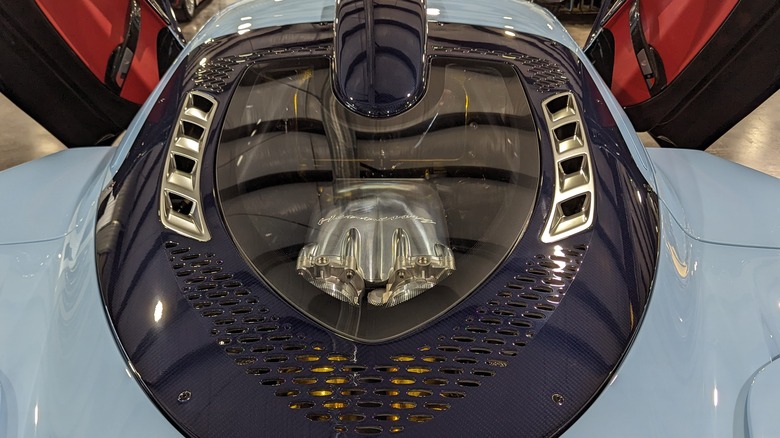
Dave McQuilling/SlashGear
While the maximum output on the F5 is indeed 1,817 horsepower, you don’t get access to all of that straight from the off. It should all max out in fourth gear or above and at around 4,000-5-000 rpm. Going from a dead start in first, you’ll get a relatively tame 850-ish according to the people at Hennessey. Ideally, you want to go forward in a straight line instead of remaining somewhat stationary while your rear tires disintegrate.
With a 0-60 time of 2.5 seconds, the Hennessey Venom F5 is no slouch. But it isn’t the quickest vehicle in this category. There are a host of other vehicles that can get to 60 before it: EVs are particularly adept at producing an initial burst of acceleration, and on paper the far more common Tesla Model S Plaid should beat the F5 to 60 by more than half a second. Even vehicles from Hennessey’s own lineup, like The Exorcist Final Edition, will hit the metric faster than the Venom F5.
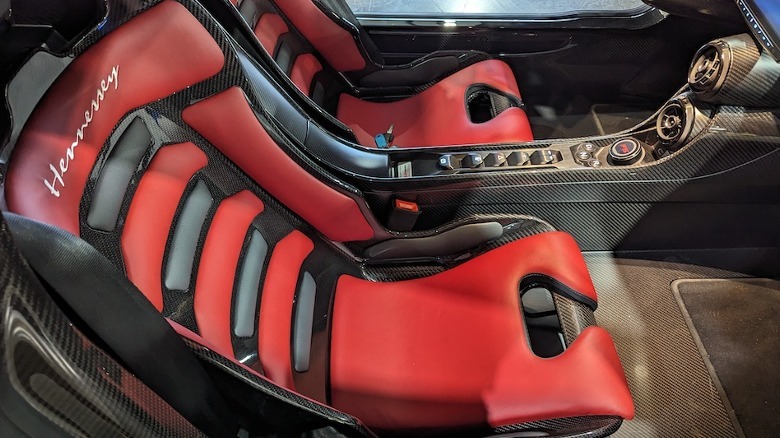
However, the F5 has some advantages over a Tesla. While you’ll feel that initial punch of acceleration in an EV, you don’t really get the full body experience. The F5 feels faster and more involved when taking off, as there’s so much more going on: that engine producing a symphony a few inches behind you, the heavy and very noticeable shifts from the gearbox, the vibrations coming through the wheel, and all amplified by the near-asphalt-scraping ride height. The F5 feels faster than its contemporaries in the same way a Miata doing 40 will «feel» faster than a Rolls Royce doing 80. You’re not a spectator, you’re right there in the middle of it.
They’re all unique
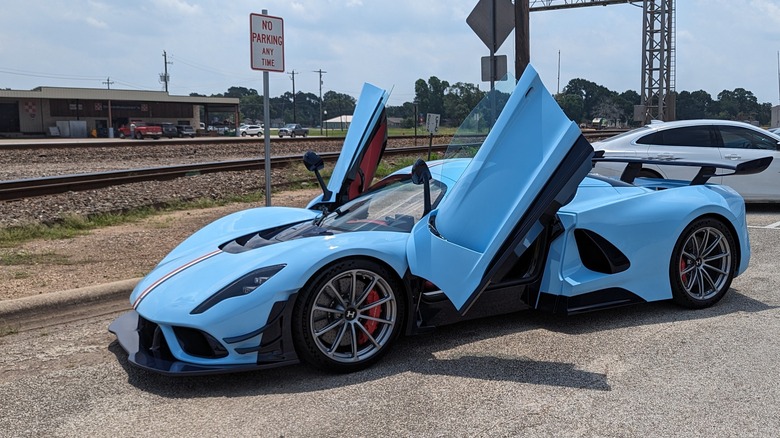
Dave McQuilling/SlashGear
With the Venom F5, there aren’t any copy jobs. Hennessy is working with each future-owner to create a visually unique piece. They aren’t using the same paint twice. Or any paint at all in some circumstances, as the occasional buyer seems to enjoy the look of bare carbon fiber.
The F5 I found myself in is owned by an avid Ferrari fan, and comes with a 1960s Le Mans inspired paint job. Said paint job, as you would expect, is impeccably done. The clear coat is sanded perfectly level, so you won’t feel a bump when sliding your finger over the racing stripes. Or, for that matter, the aluminum Hennessey badge, which is thinner than a human hair.
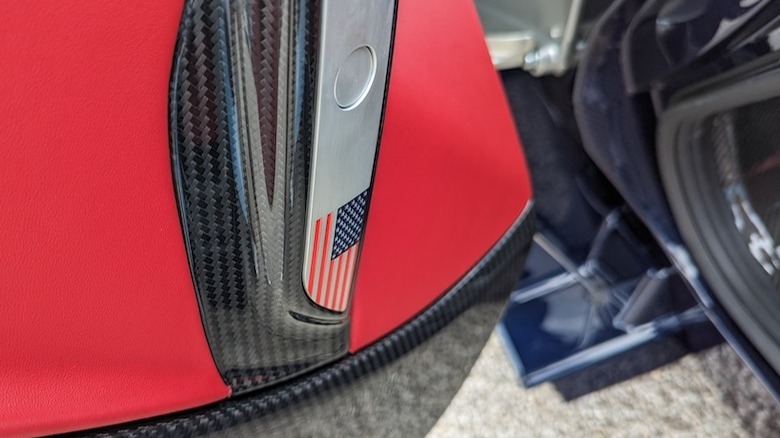
The bespoke elements stretch to the interior. You get what you may expect to some degree: plenty of options when it comes to seat colors and what materials you would like used. There’s also a chance to place some «Easter eggs» throughout the car. An example I saw had the United States flag on one interior door, and the Texas flag on another.
This was the track-focused version
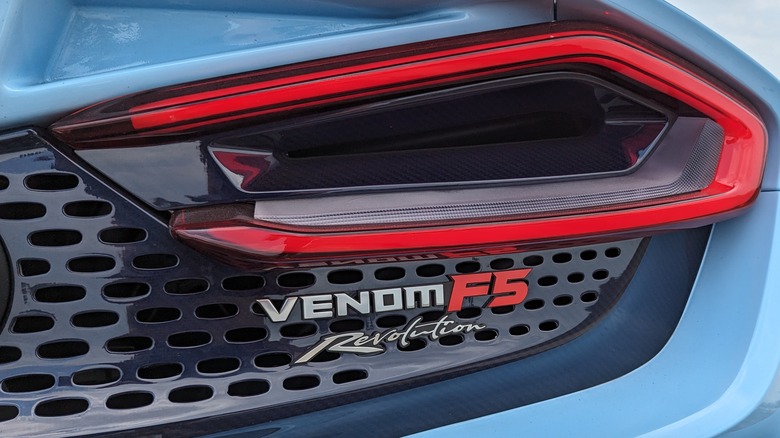
Dave McQuilling/SlashGear
There’s more than one type of Venom F5, and I was in one of the few F5 Revolution Roadsters that exist. This particular style of F5 is what was used to set the lap record at COTA and came about because one of Hennessey’s customers had their own private track on their property. The customer asked the manufacturer if it was possible to get a version of the F5 tweaked for on-track performance, and the F5 Revolution came out of that.
Notable differences include some extra bits of trim at the front to increase the amount of downforce at the front, and a carbon fiber scoop on top. While I didn’t have the chance to go for a hot lap on a world famous track–this was a customer-owned car after all–I did find the F5 Revolution incredibly drivable. If you treat the throttle with the sort of respect 1,817 horsepower warrants, you’re unlikely to run into any problems. The vehicle just goes where you want it to go.
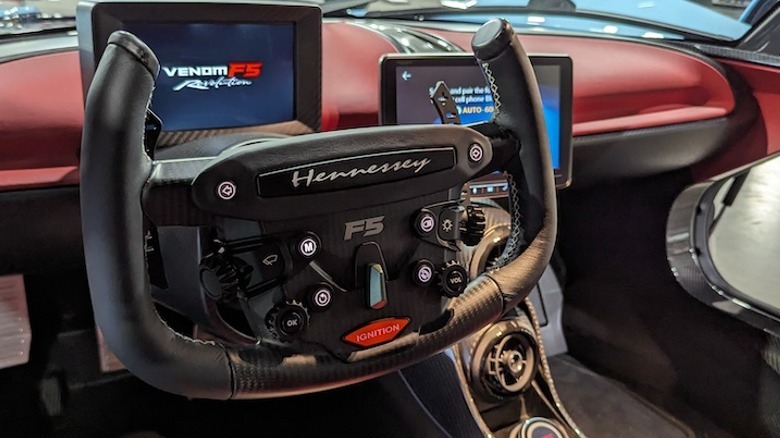
It also works on the road, even if the quirks of a yoke wheel are a bit of a pain when you need to do something like use a turn signal (which is a button, not a stalk). Driving through town is easy, though you will meet the speed limit with very little throttle input. It shines on highways too, as you know you have enough power to pull ahead and into a gap no matter what is driving in the lane beside you. However, while the performance can’t be criticized, there are some considerations you need to make if you’re eyeing an F5 up as your next daily driver.
You won’t find many comfort features
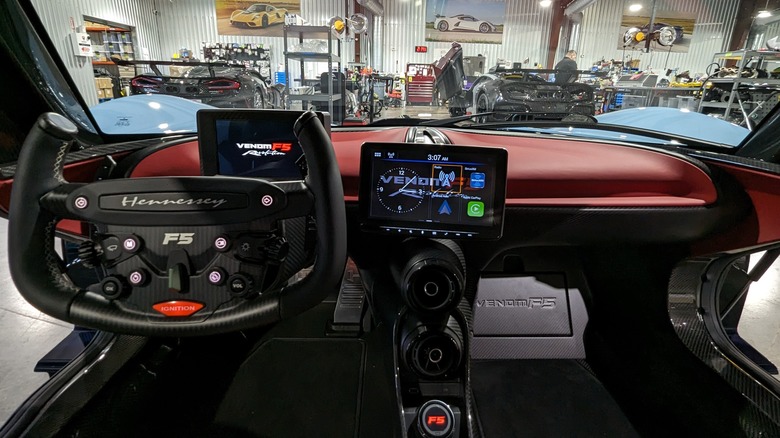
Dave McQuilling/SlashGear
The Venom F5 is not billed as a grand tourer, and while some things can be tweaked during the build you’re unlikely to find many comfort features inside of the vehicle. You’ll sit in a mildly padded bucket seat, with said-padding doing almost nothing beyond adding to the aesthetics. The suspension is firm, and the only way you could feel more of the road surface is if you opened the door, reached down, and ran your hand across it. The car has air conditioning, but that seems to be a grudging concession based around the F5’s Texas origins.
If you need to adjust your seat, you’ll need to reach between your legs and yank up a bar. Much like you do in the Mustang Dark Horse, or in that old Ford Fiesta you first learned to drive in. Obviously, given the price tag, features like massage seats, electronic seat adjustment, and a decent sound system aren’t missing for financial reasons. They’re a waste of weight, not cash, and adding unnecessary heft is a cardinal sin in any kind of sports car.
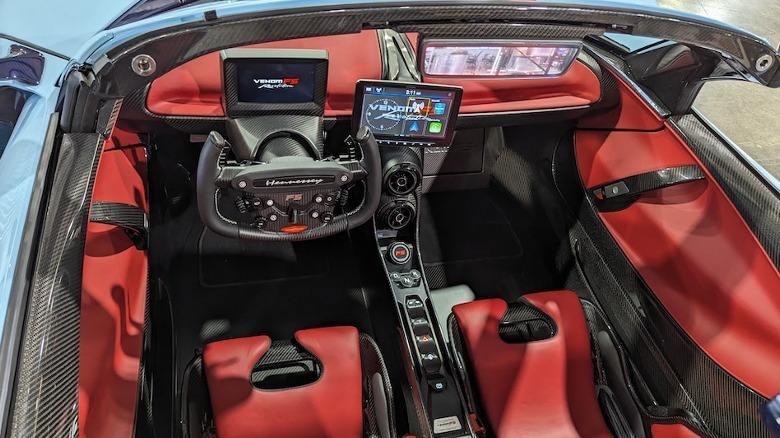
Some modern conveniences, such as USB ports, are also apparent in the F5. So while it is stripped back to basics, you’re not exactly wanting for anything. The aesthetics are on point, the weight is kept down, and that street-legal race car feeling is preserved.
Infotainment has been outsourced
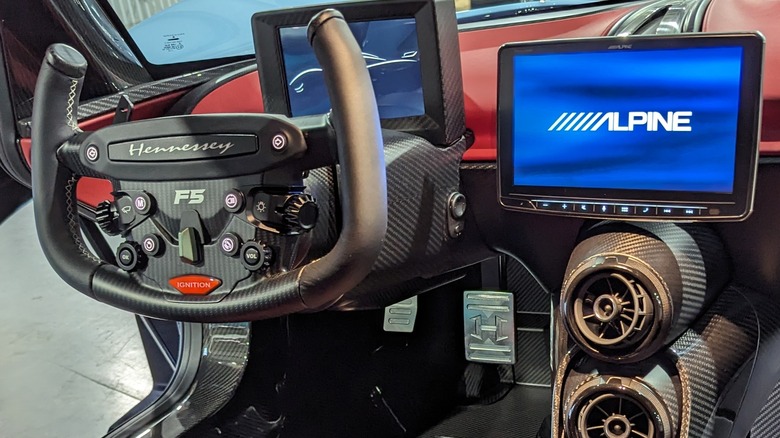
Dave McQuilling/SlashGear
Hypercar manufacturers don’t tend to make every bit of a hypercar themselves. The McLaren F1 famously yanked its tail lights from a bus, and the Jaguar XJ220 pulled its wing mirrors from a Citroen. Hennessey has actually designed and built a lot of the F5 itself, including the vehicle’s tail lights, but a couple of things–including the brakes–have been left to an outside company. The infotainment system is also on the list of things Hennessey found it was better to outsource, and that’s fine. The Alpine system in place has both Android Auto and Apple Car Play, and the chances are customers are going to use one of those anyway.
The central display, a 9.0-inch touchscreen, is very easy to use and navigate, a tiny 1.3-inch touchscreen is used to control the AC, and a 7-inch display behind the wheel tells the driver what’s going on. Anything you play will make its way through two speakers in the rear, and the sound quality isn’t great. There’s also something excessively loud right next to those speakers that you should probably be listening to instead. Popping on some Arctic Monkeys seems like sacrilege when you’re sitting inches from the world’s most powerful V8 engine.
What’s a drive in the Venom F5 actually like?
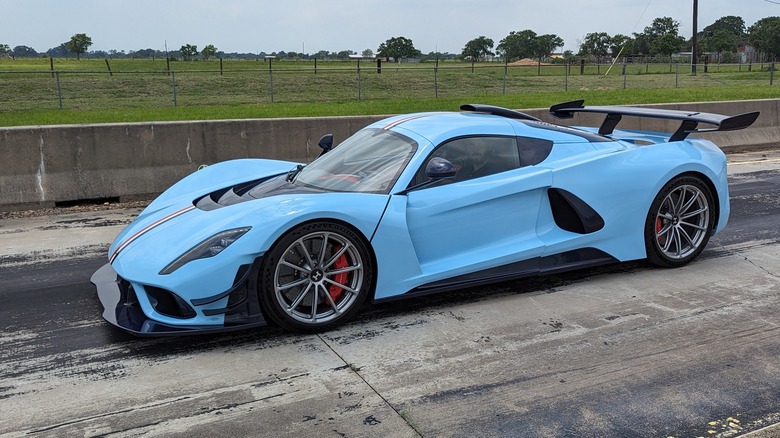
Dave McQuilling/SlashGear
Nobody buys a Venom F5 to do the Costco shop in, though. Instead, it’s about getting an organ-crushing lesson in the true meaning of the word «visceral,» and that starts with lowering yourself–entirely gracelessly–into the firm driver’s seat and perhaps wondering where the six-point harness is.
Stab the starter button, and the V8 behind you roars to life, competing with your own nerves for enthusiasm. Assuming everything in front of you is straight and clear, you might be tempted to get your foot down. Don’t mash it though, it’ll punish you for that. As my handler from Hennessey cautioned, the accelerator has to be applied smoothly, though don’t mistake a gentle touch for anything like restraint: you’ll still be crushed into the bucket seat as the F5 roars off.
The speed is unmistakable, but this is a full-five-sense assault, and your adrenal glands are being rung out like an old dish sponge by this point. Close to overwhelmed, it takes what little focus you have spare to remember to keep your shoulders loose enough to actually steer properly.
Oh good, the brakes work

Dave McQuilling/SlashGear
Eventually–and maybe feeling a little relieved–you’ll have to slam on the brakes and give silent thanks that they, too, do a very good job. The F5 feels stable, but it’s the brainchild of a man who looked at a Dodge Viper in the mid-90s and thought «y’know what, that thing could use more horsepower.» The result is a situation where you really want to stick to your limits. Or, listen to the guy from Hennessey who is sitting in the passenger’s seat, if one is available.
After coming to a stop, and spending a bit of time working out how to put the F5 into park, shutting it off and dragging yourself out is a chance to take a few deep breaths. Adrenaline does certain things to you, and you may feel like you’ve just ran a marathon. You’ll also start to go over the experience in your head, and process little bits of it that weren’t apparent at the time. In short, it’s not a drive, it’s a 1,817 horsepower adventure. It’s almost a shame the F5 isn’t a bit slower, then the whole thing would’ve lasted longer.
John Hennessy has built what he said he would build

Dave McQuilling/SlashGear
Yet-to-be-set records aside, the Venom F5 drives exactly how Hennessy said it would drive. The Texan manufacturer was aiming for a «visceral experience,» and that’s arguably the best way to describe the 1,817 horse hellbeast he has now unleashed on the world. It is road legal, but it feels road legal in the minor compromises and box ticking sense. This isn’t something you’re picking the kids up from school in. This isn’t a vehicle you road trip across the country in. It’s a race car with a license plate: something you hop in when you want to make sure your adrenal glands are still functioning.
The noise pumped out by the V8 actively seething behind your head, the vibrations, the smell, the steering response, the weird sense of detachment from the outside world and existing in the moment. It’s all pretty much exactly what you’ll feel in something built purely for racing. You’re just missing the roll cage and six-point harness.
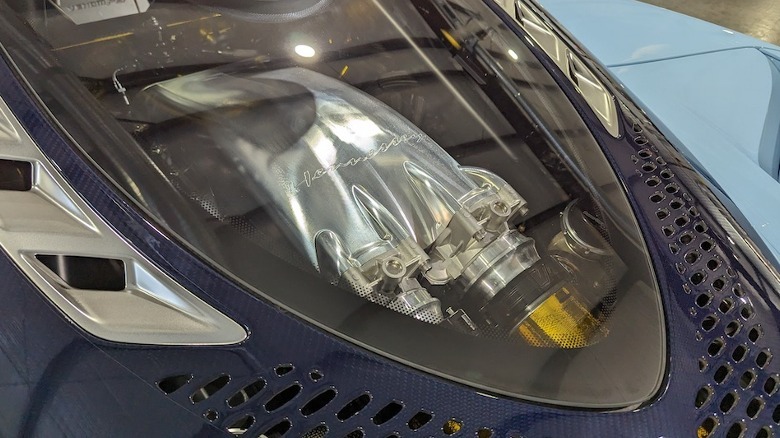
If you love driving in its purest form, this is a must-have. Unfortunately, the current $3 million-ish price tag isn’t the only thing standing between you and a Venom F5. Hennessy is only planning on producing 99 of them.
Its spiritual ancestor, the McLaren F1, had a run of 106 (though not all of those were road-legal). That means Hennessey’s cars are going to be pretty hard to spot, never mind own. Still, the F5 is a truly special machine, an engineering marvel, so if you’re lucky enough to get near one, you should really make the most of it.